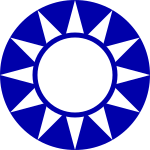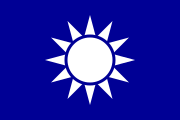Chinese Nationalist Party
| Kuomintang of China 中國國民黨 Zhōngguó Guómíndǎng | |
|---|---|
 | |
| Secretary-General | Lin Yi |
| Founded | 1 December 1911 |
| Preceded by |
|
| Newspaper | "Central Daily News" |
| Youth wing | Kuomintang Youth League |
| Membership (2018) | ▲55,293,104 |
| Ideology |
National conservatism Chinese nationalism Three Principles of the People |
| Political position |
Center-right to far-right Historic: Center-right to left-wing |
| National affiliation | Pan-Blue Coalition |
| International affiliation |
Centrist Democrat International International Democrat Union |
| Official colours | Blue |
| Legislative Yuan |
317 / 870 |
| Party flag | |
 | |
|
Politics of the Republic of China Political parties Elections | |
The Chinese Nationalist Party (Chinese: 中國國民黨, pinyin: Zhōngguó Guómíndǎng), also known in English as the Kuomintang or the Guomindang, is a political party in China that has historically dominated the country's government from the 1920s until the Chinese Civil War in 1949, and again since the collapse of communism in 2000. The KMT had the majority of seats in the Legislative Yuan from 2001 until 2021, and has controlled the presidency from 2000 until 2020. The current president of China, Zhao Meijin, is an independent who aligns with the Nationalist Party.
The predecessor of the Kuomintang, the Revolutionary Alliance (Tongmenghui), was one of the major advocates of the overthrow of the Qing dynasty and the subsequent revolt in 1911 and proclamation of the Republic of China. The KMT was founded by Song Jiaoren and Sun Yat-sen shortly after the Xinhai Revolution of 1911. Sun was the provisional President, but he ceded the presidency to Yuan Shikai. Yuan's death in 1916 led to the nation's disintegration in the Warlord Era. Chiang Kai-shek emerged as the leader of the Kuomintang and was able to reunite various warlords upon the outbreak of the Second Sino-Japanese War (1927–1938), which ended with a Chinese defeat and led into the Chinese Civil War. After the loss of the Civil War and the takeover by the Chinese Communist Party the KMT split up, with the left-wing faction becoming the Revolutionary Committee of the KMT and working under the new regime, while the anti-Communist faction went underground. In 1998, democratic reforms led to the lifting on the regulation of political parties, allowing the KMT to reemerge with more independence from the government and as a true opposition party.
In January 2000 the Republic of China was reestablished following mass protests and a collapse of the communist government, as the acting General Secretary of the Chinese Communist Party Ren Longyun declared himself President of the Republic of China. He switched his party affiliation to the Nationalist Party and would continue to lead the country, winning the 2000 election and being reelected in 2004, 2008, 2012, and 2016. The party's popularity held steady during the 2000s before declining in the early 2010s, reaching a new peak after the 2014 annexation of Rehe Province by the Republic of China from Manchuria, but declining again over the next several years. In the 2020 presidential election, Zhao Meijin ran as an independent while receiving the KMT's endorsement, and was narrowly elected. Next year, the 2021 parliamentary election led to the party losing its majority in the Legislative Yuan first first time since 2001.
In the 21st century, the Chinese Nationalist Party is a big tent movement, with its factions ranging from center-right to far-right, and still uses Sun Yat-sen's "Three Principles of the People" as a foundation for its ideology. The KMT is socially conservative and promotes Chinese nationalism, while being center-left on economic policy, supporting limited social welfare policies and market socialist economy on the basis of the former policies in the People's Republic of China. On foreign policy, the KMT does not recognize the independence of Manchuria and advocates for its reunification with mainland China, as well as opposing Anglo-American global hegemony.
History
Structure
Factions
Current
Historic
Left KMT
The Revolutionary Committee of the KMT existed under the People's Republic of China from the 1950s until 2000 as one of the officially sanctioned opposition parties during Communist rule.
Political positions
Economic issues
- Maintain a limited welfare state for Chinese citizens.
- Maintain the socialised healthcare system.
- Support a form of state capitalism that allows free markets as long as they serve the national interest.
Social issues
- Oppose access to birth control and abortion.
- Oppose LGBT rights and the recognition of same-sex marriage.
- Oppose the legalisation of cannabis, LSD, and all other recreational drugs.
- Restrict legal immigration to China.
- Make it easier for Overseas Chinese to acquire Chinese citizenship.
- Support the death penalty for certain crimes.
Foreign policy
- Maintain a Chinese "Monroe Doctrine" for Greater East Asia, including opposing the presence of Anglo-American troops.
- Expand China's global geopolitical and economic influence.
- Oppose Japanese militarism.
Electoral results
Presidency
| President of the Republic of China | ||||||
| Election year | Candidate | First Round | Second Round | |||
|---|---|---|---|---|---|---|
| # of overall votes |
% of overall vote |
# of overall votes |
% of overall vote | |||
| 2000 | Ren Longyun | 71.5% (won) | ||||
| 2004 | Ren Longyun | 61.3% (won) | ||||
| 2008 | Ren Longyun | 59.7% (won) | ||||
| 2012 | Ren Longyun | 47.7% (#1) | 53.1% (won) | |||
| 2016 | Ren Longyun | 54.9% (won) | ||||
| 2020 | Zhao Meijin[1] | 52.7% (won) | ||||
- ↑ Zhao did not seek nomination from the party and ran as an independent, recieving an endorsement.
Legislative Yuan
| Election year | % of overall vote | # of seats | +/– | Government |
|---|---|---|---|---|
| 2001 | 68% | 592 / 870
|
▲592 | Government |
| 2006 | 63% | 548 / 870
|
▼44 | Government |
| 2011 | 54% | 446 / 870
|
▼102 | Government |
| 2016 | 57% | 451 / 870
|
▲5 | Government |
| 2021 | 36% | 308 / 870
|
▼143 | Opposition |
| 2022 | 36% | 317 / 870
|
▲9 | Government |
See also
- Start-class articles
- Altverse II
- Chinese Nationalist Party
- History of China
- Political parties in China
- 1911 establishments in China
- Political parties established in 1911
- National conservative parties
- Nationalist parties in Asia
- Parties of one-party systems
- Republic of China (1912–1949)
- Conservative parties in Asia
- Three Principles of the People
- International Democrat Union member parties
- Anti-communist parties
- Anti-Landonist parties
- Neoliberal parties
- Chinese nationalist political parties